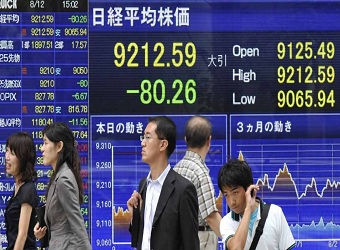Asia stocks steadied on Wednesday after stuttering in the wake of rising global bond yields, while the dollar came under renewed pressure, slipping to 2-1/2-year lows versus the yuan, ahead of the Federal Reserve’s policy decision.
In his first State of the Union address since becoming U.S. President, Donald Trump urged Republicans and Democrats to work toward compromises on immigration and infrastructure and implement legislation that generates at least $1.5 trillion for new infrastructure investment.
U.S. stock futures rose 0.15 percent, though overall market reaction to the speech was limited.
“Futures lifted a bit because it was not a negative speech. He was calm. He celebrated America. He avoided his own failures,” said Tim Ghriskey, Chief Investment Officer at Cresset Wealth Advisors in Chicago.
European shares are expected to open higher, with spread-betters looking at gains of 0.2 percent in Germany’s Dax and 0.1 percent each in Britain’s FTSE and France’s Cac.
MSCI’s broadest index of Asia-Pacific shares outside Japan advanced 0.3 percent, reversing earlier losses. January has so far seen the index gain 6.5 percent, putting it on course for its best month since March 2016.
Japan’s Nikkei however dropped 0.8 percent, though still capping a monthly gain of 1.5 percent.
Wall Street, which has recently hit a succession of record peaks, has led a global equities rally over the past year thanks to strong world growth fuelling higher corporate earnings and stock valuations.
But the recent surge in U.S. long-term bond yields to near four-year highs has tempered the rally.
U.S. stocks fell for a second straight day on Tuesday, with the Dow registering its biggest two-day drop since September 2016, pressured by healthcare stocks and rising bond yields. [.N]
“The key point is the speed of the latest rise in yields, which has been very rapid. Until recently the yield rise helped the financial sector, but the pace of the rise is now too rapid and raising worries about corporate borrowing costs,” said Junichi Ishikawa, senior FX strategist at IG Securities in Tokyo.
Higher yields are seen hurting equities as they increase borrowing costs for companies and reduce their risk appetite. They also present a fresh alternative to investors, who may choose to allocate some of their money from equities to bonds.
The U.S. Treasury 10-year note yield touched its highest in nearly four years overnight at 2.733 percent, while 30-year bond yield climbed to its highest since May 2017.
Yields rose after the start of the Federal Reserve’s two-day meeting on Tuesday, which could offer more clues on the central bank’s economic and rate hike outlook.
The dollar failed to draw much support from higher Treasury yields as the risk-averse mood favored its peers like the yen.
The dollar was flat at 108.72 yen. It briefly popped up to 109.095 after the Bank of Japan increased its buying of government bonds of three- to five-year maturities at a regular debt-purchasing operation, a move seen as a warning shot against further rises in yields.
The euro nudged up 0.3 percent to $1.2436, adding to modest overnight gains.
The dollar index against a basket of six major currencies was at 88.971, having crawled away from a three-year low of 88.438 set on Friday.
The dollar lost 0.4 percent against the Chinese yuan, falling below 6.3 yuan for the first time since August 2015.
The risk aversion in the broader markets took a toll on recently bullish crude oil. U.S. crude futures stretched overnight losses to slide 0.6 percent to $64.11 per barrel, with data showing a higher-than-expected rise in stocks also weighing.
Underpinned by the dollar’s recent slide, prices had risen to $66.66 per barrel on Thursday, the highest since December 2014.
Brent crude was down 0.5 percent at $68.66 per barrel.
Source: Reuters



